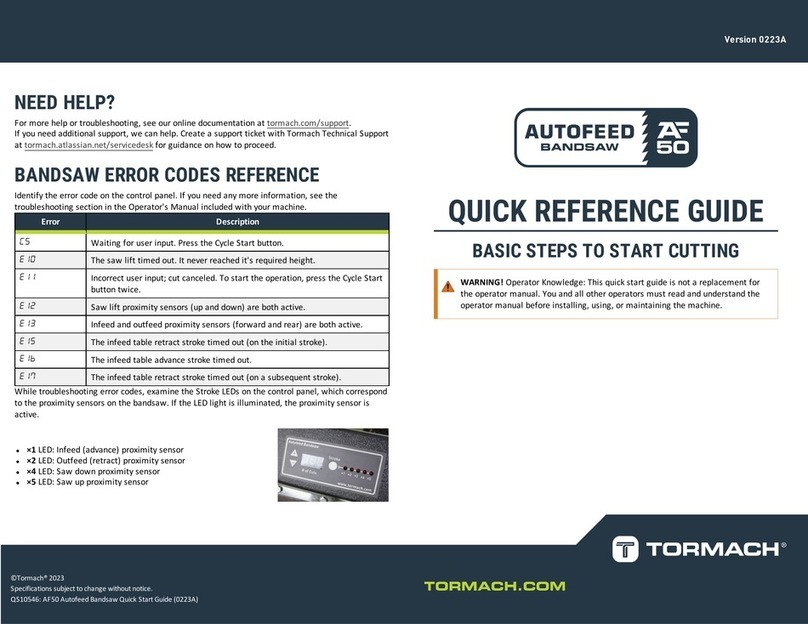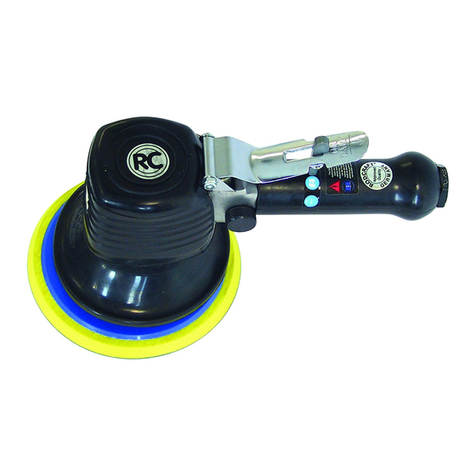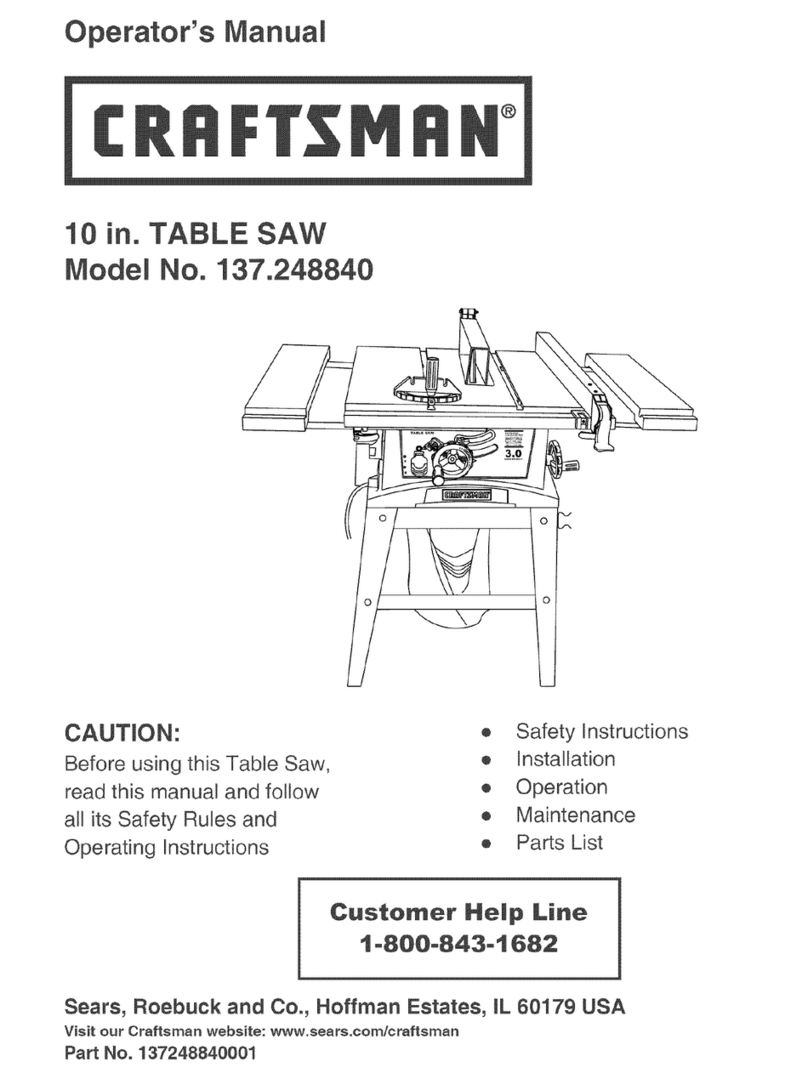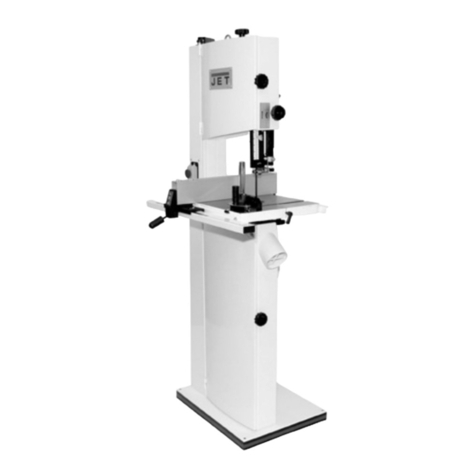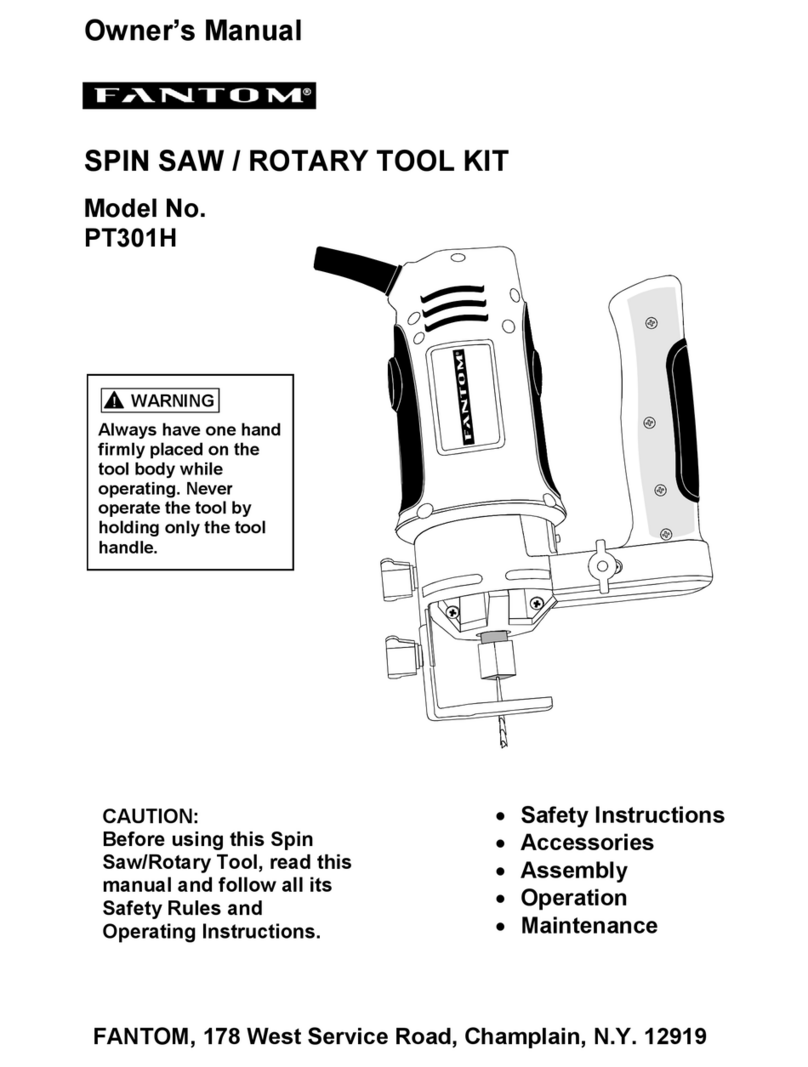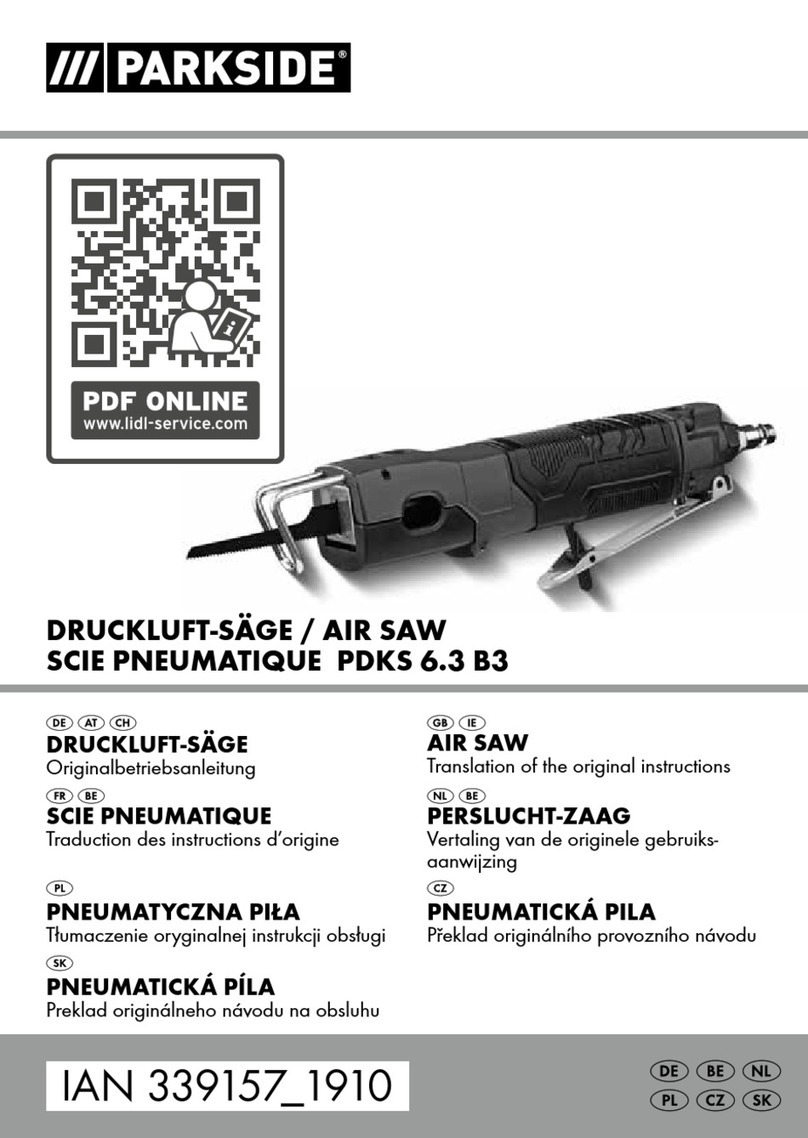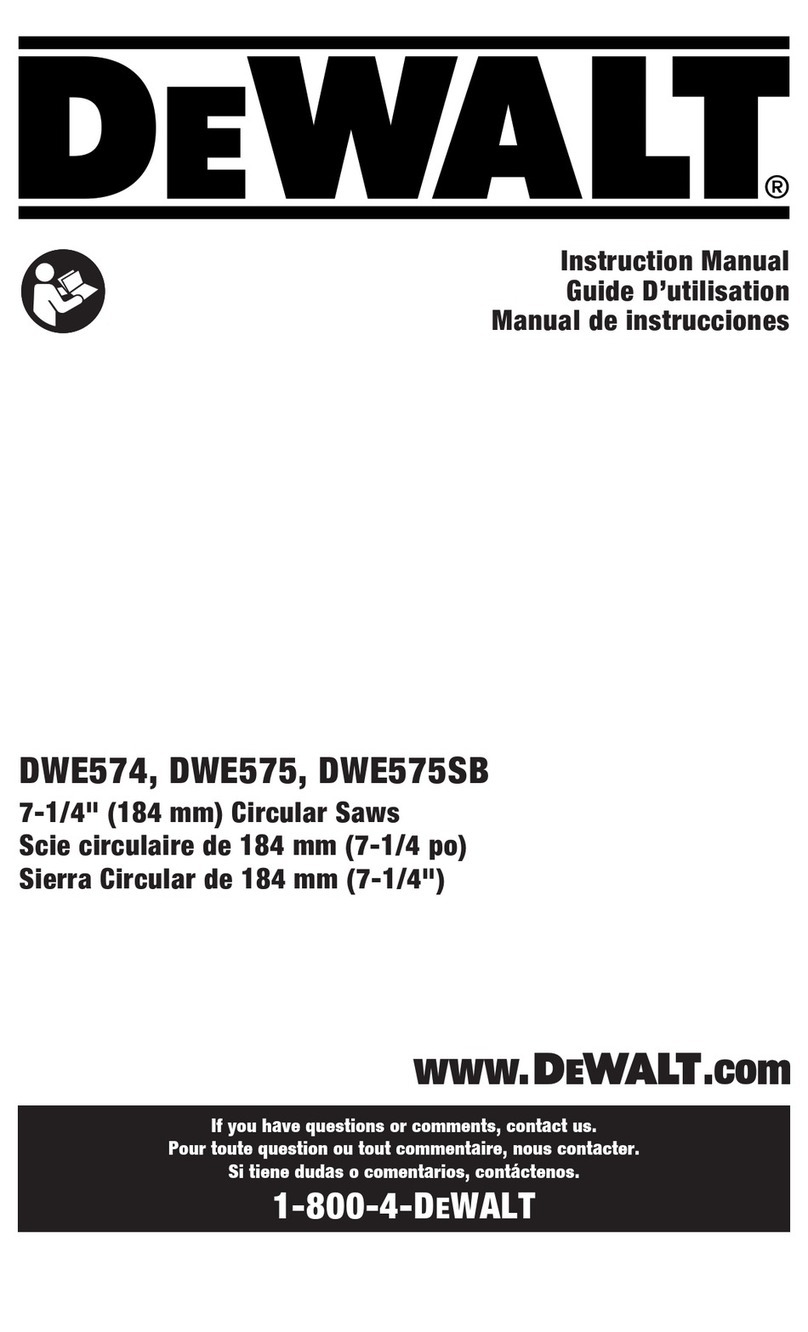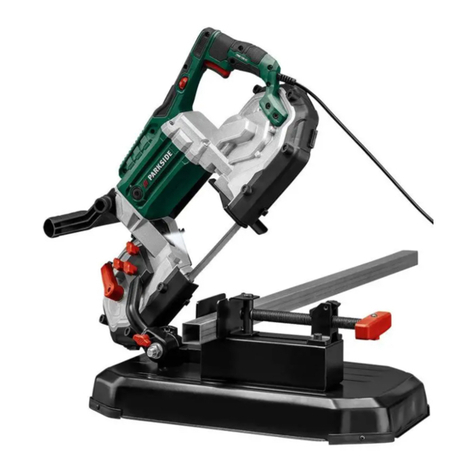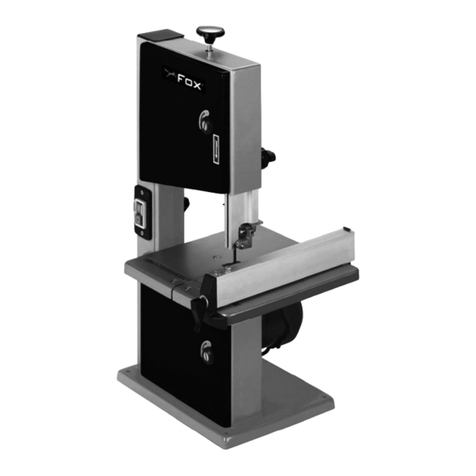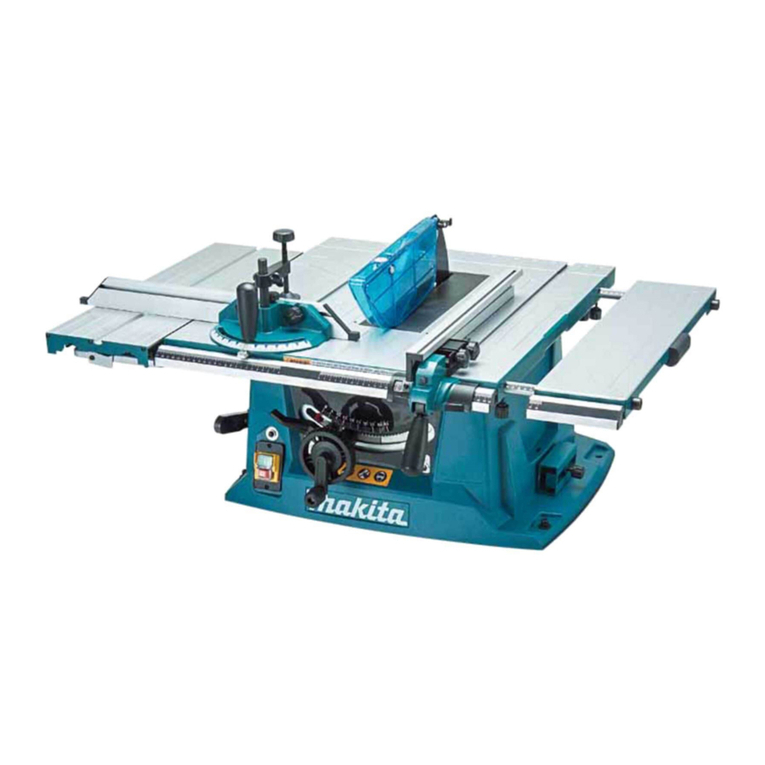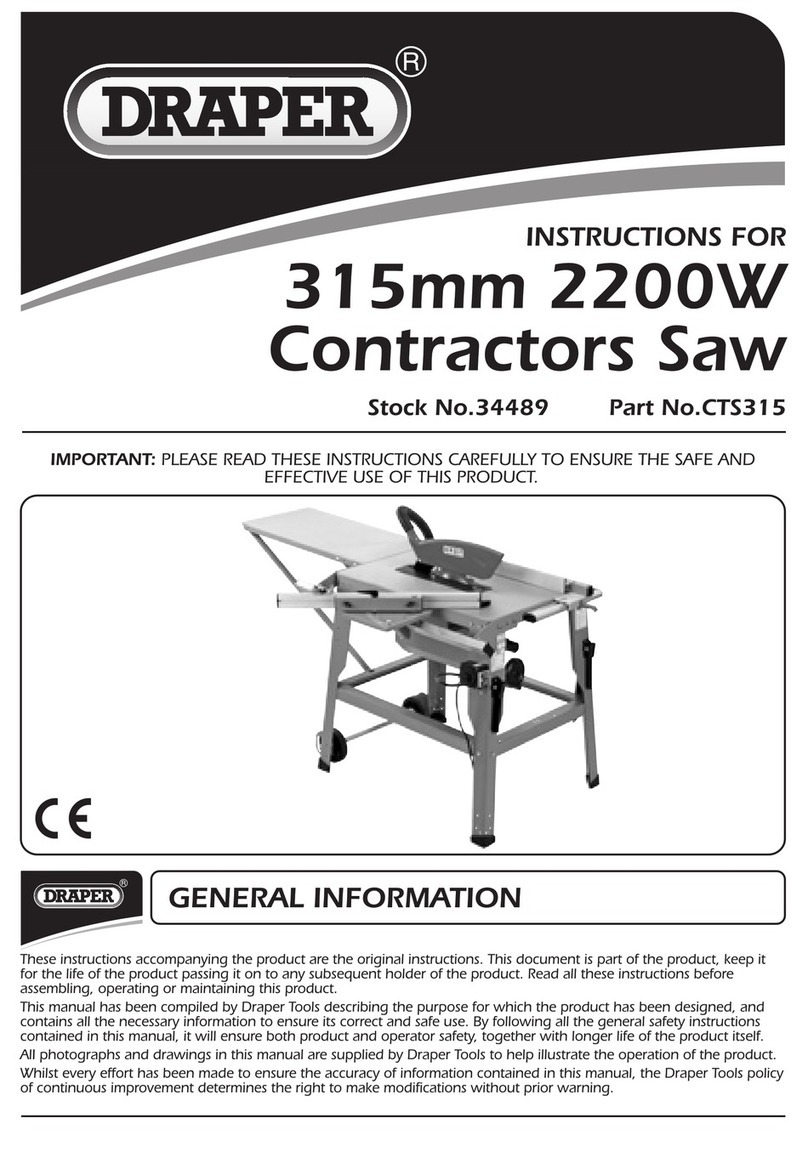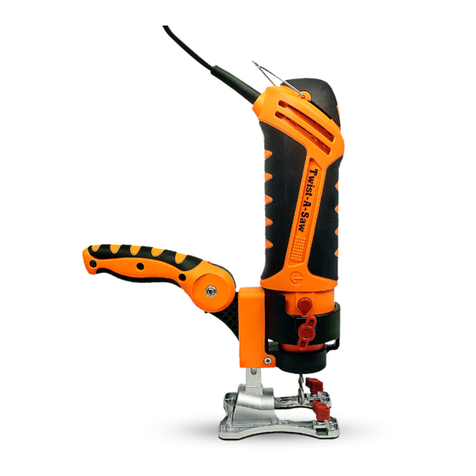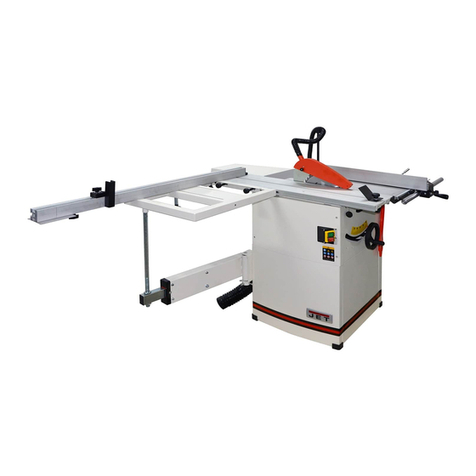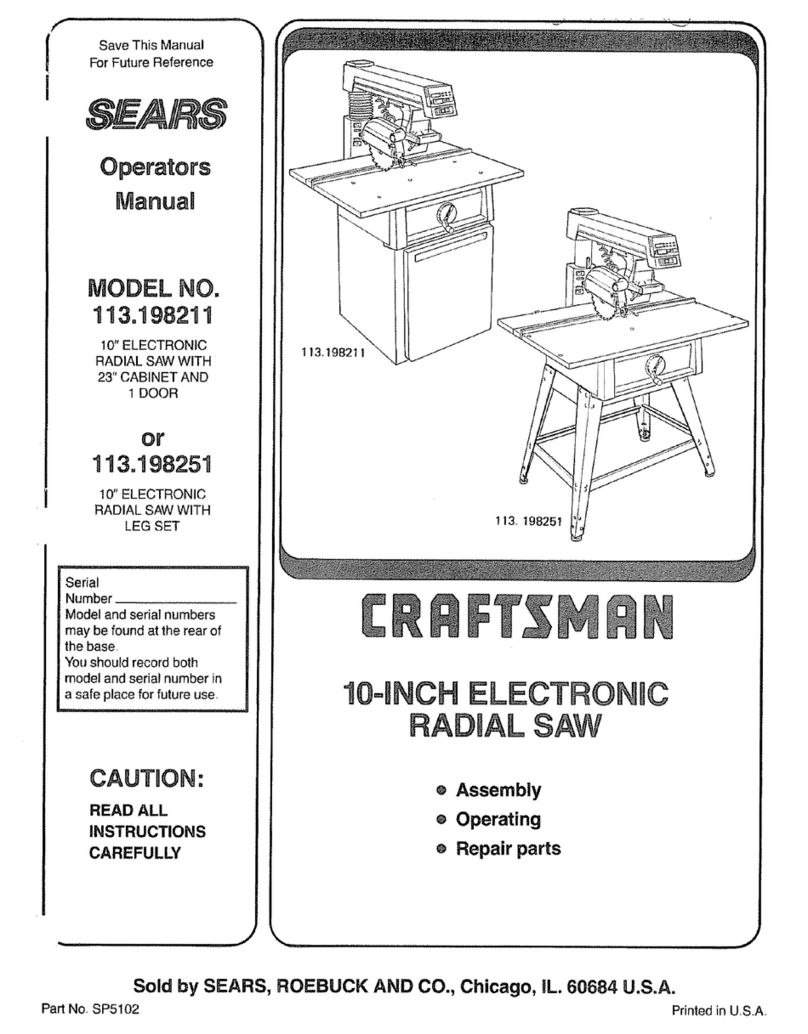Tormach Autofeed Bandsaw AF50 User manual

Original Instructions
OPERATOR'S MANUAL Version 0320A

Copyright
Notice
Information is subject to change without notice by Tormach, Inc. For the most recent version of this document,
see tormach.com/support.
You're welcome to make copies of this document for evaluating, learning about, and/or using the machine.
You may not charge for any copies you make beyond the cost of printing.
Unless otherwise noted, companies, names, and various data used in examples are fictitious.
To the Reader
We're dedicated to continually improving our documentation and products, and welcome any clarifications,
corrections, or suggestions.
Credits
Tormach®, AF50 Autofeed Bandsaw®, and PathPilot® are trademarks or registered trademarks of Tormach,
Inc. Our milling machines and accessories are covered by one or more of the following U.S. Patents: 7,386,362;
D606,568; D612,406; D621,859; and other patent(s) pending.
Other product or company names may be the trademarks of their respective owners.
Copyright © Tormach, Inc. 2020
Page 2

SAFETY 9
1.1 Safety Overview 10
1.1.1 Safety Messages 10
Personal Injury 10
Property Damage 10
1.2 Machine Safety 10
1.2.1 General Shop Safety 10
1.2.2 Operational Safety 10
General 10
Blades 11
Workholding 11
1.2.3 Electrical Safety 11
ABOUT YOUR MACHINE 13
2.1 Specifications Reference 14
SITE REQUIREMENTS 17
3.1 General Site and Space Requirements 18
3.1.1 Site Requirements 18
3.1.2 Space Requirements 18
3.2 Electrical and Power Requirements 18
3.2.1 Electrical Requirements 18
3.2.2 Power Requirements 18
3.3 Air Requirements 18
INSTALLATION 19
4.1 Before You Begin 20
4.2 Move the Crate 20
4.3 Unpack the Crate 20
4.4 Set Up the Machine 21
4.4.1 Level the Machine 21
4.4.2 Install the Coolant Tank 21
4.4.3 Install the Blade Tensioner Handles 22
4.4.4 Remove the Shipping Bolts on the Rear Cage 22
4.4.5 Install the Rear Roller 22
4.4.6 Make Air Connections 22
Air Requirements 23
4.4.7 Verify the Alignment of the Fixed Jaw 23
4.4.8 Verify the Alignment of the Infeed Table 23
4.5 Verify the Installation 24
TABLE OF CONTENTS

©Tormach® 2020
Specifications subject to change without notice.
Page 4 UM10538: Tormach AF50 Autofeed Bandsaw (Version 0320A)
For the most recent version, see tormach.com/support
4.5.1 Verify the Proximity Sensor Installation 24
4.5.2 Power On the Machine 24
4.5.3 Power Off the Machine 24
SYSTEM BASICS 25
5.1 Controls Overview 26
5.1.1 Machine Controls 26
5.1.2 Program Controls 26
BASIC OPERATIONS 27
6.1 Choose a Blade 28
6.2 Change a Blade 28
6.2.1 Install a New Blade 28
6.2.2 Verify the Blade Installation 30
6.2.3 Break in the Blade 30
6.3 Change the Speed 31
6.4 Change the Feed Rate 31
6.5 Change the Clamping Pressure 32
6.6 Set the Number of Cuts 32
6.7 Set the Number of Cycles 32
AUTOMATIC OPERATION 33
7.1 Use Automatic Mode 34
MANUAL OPERATION 37
8.1 Use Manual Mode 38
MACHINE MAINTENANCE 41
9.1 Machine Safety 42
9.2 Maintenance Schedules 42
9.2.1 Daily 42
9.2.2 Weekly 42
9.2.3 Monthly 42
9.2.4 Semi-Annually 42
9.3 Replace the Gearbox Oil 42
MECHANICAL ADJUSTMENTS 43
10.1 Adjust the Blade Guides 44
10.2 Adjust the Blade Tracking 44
10.3 Adjust the Blade Brush 46
10.4 Adjust the Height of the Infeed Table 46
TABLE OF CONTENTS

©Tormach® 2020
Specifications subject to change without notice.
Page 5 UM10538: Tormach AF50 Autofeed Bandsaw (Version 0320A)
For the most recent version, see tormach.com/support
TABLE OF CONTENTS
10.5 Adjust the Jaws 47
10.5.1 Align the Fixed Jaw 47
10.5.2 Adjust the Fixed Clamp Jaw 47
TROUBLESHOOTING 49
11.1 Operations Troubleshooting 50
11.1.1 Blades Break Too Frequently 51
11.1.2 Blades Dull Too Quickly 53
11.1.3 Blades Lose Teeth 54
11.1.4 Cuts Are Crooked 55
11.1.5 Material Doesn't Advance 56
11.1.6 Material Slips in Vise Clamps 57
11.1.7 Noise or Problems Moving Through the Cut 58
11.2 Motor and Electrical Troubleshooting 59
11.2.1 Coolant Pump Doesn't Work 60
11.2.2 Error on the Control Panel 62
Control Panel Displays CS 62
Control Panel Displays E** 62
Bandsaw Error Codes Reference 62
11.2.3 Machine Doesn't Start or a Panel Breaker Trips 64
11.2.4 Machine Stalls or It's Underpowered 65
11.2.5 Noise or Machine Vibration 67
DIAGRAMS AND PARTS LISTS 69
12.1 Base Casting Exploded View 70
12.2 Base Casting Parts List 71
12.3 Head Casting Exploded View 73
12.4 Head Casting Parts List 74
12.5 Infeed Table Exploded View 77
12.6 Infeed Table Parts List 78
12.7 Stand Exploded View 80
12.8 Stand Parts List 81
PNEUMATIC SCHEMATICS 83
13.1 Bandsaw Pneumatics 84
ELECTRICAL SCHEMATICS 85
14.1 115 Vac Power 86
14.2 Controls and Sensors 87
14.3 Terminal Strips 88
14.4 Electrical Panel Layout 89

ABOUT THIS DOCUMENT
SAVE THESE INSTRUCTIONS!
This document contains important safety warnings and
operating instructions for your machine. Before operating this
machine in any way, you and all other operators must read and
understand all instructions. If you don't, there's a risk of voided
warranty, property damage, serious injury, or death.
Keep these instructions with your machine so that they're
readily accessible.
PURPOSE AND SCOPE
This document is intended to provide sufficient information to
allow you to install, configure, and use your machine. It
assumes that you have appropriate experience and/or access
to training.
GETTING HELP
We provide no-cost technical support through multiple
channels. The quickest way to get the answers you need is
normally in this order:
1. Read this document.
2. Read related documents at tormach.com/support.
3. If you still need answers, gather the following
information so that we may help you as quickly as
possible:
lYour phone number, address, and company name (if
applicable).
lMachine model and serial number, which are located
next to the Main Disconnect switch.
lAny accessories that you have for your machine.
lA clear and concise description of the issue.
lAny supporting media and information that you can
share with us. For example, you could:
oAnalyze what might have changed since the
machine last worked correctly.
oRecord a short video.
oTake a picture of a part.
oUse a digital multimeter for voltage readings.
4. Once you've gathered the information in Step 3, contact
us in the following ways:
a. Email: support@tormach.com
b. Phone: (608) 849-8381 (Monday through Friday, 8
a.m. to 5 p.m. U.S. Central Standard Time)
ADDITIONAL INFORMATION
For additional technical information and support videos, see
tormach.com/support.
LIABILITY DISCLAIMER
We've made every effort to provide comprehensive and
accurate information, but no warranty or fitness is claimed or
implied. All information provided is on an as is basis. The
authors, publisher, and Tormach, Inc. ("we", "us", and so on)
shall not have any liability for, or responsibility to, any person
or entity for any reason for any loss or damage arising from
the information contained in this document.
This document provides guidance on safety precautions and
techniques, but because the specifics of any one workshop or
other local conditions can vary greatly, we accept no
responsibility for machine performance or any damage or
injury caused by its use. It's your responsibility to verify that
you fully understand the implications of what you're doing and
comply with any legislation and codes of practice applicable to
your city, state, or nation.
©Tormach® 2020
Specifications subject to change without notice.
Page 7 UM10538: Tormach AF50 Autofeed Bandsaw (Version 0320A)
For the most recent version, see tormach.com/support


SAFETY
IN THIS SECTION, YOU'LL LEARN:
About the standards and safety precautions associated with this machine.
Before operating the machine in any way, you must read and understand this section.
Safe operation of the machine depends on its proper use and the precautions you take. Only trained personnel
— with a clear and thorough understanding of its operation and safety requirements — shall operate this
machine.
CONTENTS
1.1 Safety Overview 10
1.2 Machine Safety 10

1.1 SAFETY OVERVIEW
Before operating the machine in any way, you must read and
understand this section.
lRead and understand all safety messages used in this
document.
lLocate and understand all safety decals on the machine.
lLocate and become familiar with all information decals
on the machine.
1.1.1 Safety Messages
The following examples show the standard safety message
types used to draw your attention to important information.
The standards distinguish between personal injury safety
messages and property damage warning messages.
Personal Injury
Personal injury safety messages have safety alert symbols and
the following hazard level labels:
DANGER! Indicates a hazard with a high level of risk
which, if not avoided, will result in death or serious
injury.
WARNING! Indicates a hazard with a medium level
of risk which, if not avoided, can result in death or
serious injury.
CAUTION! Indicates a hazard with a low level of risk
which, if not avoided, can result in minor or moderate
injury.
Property Damage
NOTICE! Indicates a hazard which, if not avoided, can
cause property damage.
1.2 MACHINE SAFETY
Before operating the machine in any way, you must
read and understand this section.
Safe operation of the machine depends on its proper use and
the precautions you take. Only trained personnel — with a
clear and thorough understanding of its operation and safety
requirements — shall operate this machine.
1.2.1 General Shop Safety 10
1.2.2 Operational Safety 10
1.2.3 Electrical Safety 11
1.2.1 General Shop Safety
Verify that only qualified machinery maintenance
professionals install, set up, or perform maintenance on
this machine.
Keep the work area well-lit. Use additional lighting if
needed. The work area should be illuminated to a
minimum of 500 lx.
Keep the work area temperature- and humidity-controlled.
Remove loose-fitting clothing, neckties, gloves, and
jewelry.
Tie up long hair and secure it under a hat.
Wear safety eye protection rated for ANSI Z87+.
Wear closed-toed safety shoes.
Wear ear protection when you expect the machine or the
machining processes to exceed safe exposure limits.
Keep the work area clean and free of clutter. Machine
motion can occur if controls are accidentally activated.
Immediately clean up spills after they occur.
Never operate the machine after consuming alcohol or
taking medication that could prevent you from safely
operating the machine.
Never operate the machine while tired or otherwise
impaired.
Never operate the machine in an explosive (ATEX)
atmosphere. Such explosive atmospheres include
explosive gases, vapors, mists, powders, and dusts.
1.2.2 Operational Safety
General
Understand that the machine is automatically controlled
and can start at any time.
Become familiar with all physical controls.
Always use a chip scraper or brush when clearing away
chips, oil, or coolant.
©Tormach® 2020
Specifications subject to change without notice.
Page 10 UM10538: Tormach AF50 Autofeed Bandsaw (Version 0320A)
For the most recent version, see tormach.com/support
1: SAFETY

1: SAFETY
Examine all blades, fixtures, workpieces, and guarding for
signs of damage. Replace any damaged components as
soon as you find them.
Guards may not stop all types of projectiles, like broken
blades or loose workpieces.
Stop the machine and verify that all machine motion has
completely stopped before doing any of the following:
Adjusting a part, fixture, or coolant nozzle.
Changing blades or parts.
Clearing away chips, oil, or coolant.
Reaching into any part of the machine's motion
envelope.
Removing protective shields or safeguards.
Taking measurements.
Doing any other action inside the guard.
Read the Safety Data Sheet (SDS) for all workpiece
materials, coolants, lubricants, and other consumables.
Chips, dust, and vapors from certain materials can be toxic
or otherwise harmful.
Thoroughly read all safety precautions and instructions.
Never reach around a guard.
Never allow the machine to run unattended.
Never obstruct the Emergency Stop button or any other
controls.
Never allow untrained operators to install, operate, or
maintain the machine.
Never modify, defeat, or bypass safety devices or
interlocks.
Never machine abrasive, carcinogenic, explosive,
flammable, radioactive, or toxic materials. Such materials
include, but are not limited to:
Beryllium and its alloys
Ceramic
Fiberglass
G10 fiberglass laminate
Graphite
Lead and its alloys
Magnesium and its alloys
Never allow swarf to accumulate on or within the
machine.
Blades
Examine blades for signs of damage or missing teeth.
Replace any damaged blades, or blades with missing
teeth, as soon as you find them.
Wear gloves and safety eye protection when replacing
blades.
Verify that the teeth on the blade point toward the
workpiece.
Never use worn or damaged blades, or blades with
missing teeth. Blades can break and become dangerous
projectiles.
Workholding
Secure workpieces with appropriate workholding devices.
Verify that the workpiece is adequately secured.
Remove cutoff workpieces and other large chips before
starting the machine.
Never leave tools, stock, or other loose items inside the
machine.
Never use your hands to hold the workpiece during
machining operations.
1.2.3 Electrical Safety
WARNING! Electrical Shock Hazard: You must power
off the machine before making any electrical
connections. If you don't, there's a risk of
electrocution or shock.
Power off the machine before servicing.
Understand that certain electrical components can retain
dangerous electrical voltages, even after the machine is
powered off and all power is removed from the system.
Understand that certain installation, maintenance, and
troubleshooting procedures — for the machine and certain
accessories — require access to or modification of wiring
inside of the electrical cabinet. Only qualified electrical
machinery technicians shall perform these procedures.
Confirm that the mains voltage conforms to requirements
before connecting the machine.
For more information, see "Electrical and Power
Requirements" (page18).
©Tormach® 2020
Specifications subject to change without notice.
Page 11 UM10538: Tormach AF50 Autofeed Bandsaw (Version 0320A)
For the most recent version, see tormach.com/support

Confirm that the machine installation meets all codes and
regulations of your locality.
Confirm that electrical connections are performed by a
certified electrician.
Lock the electrical cabinet door and remove the keys when
the machine is not being serviced to prevent unqualified or
unauthorized personnel from accessing the electrical
cabinet.
Never operate the machine with the electrical cabinet
door open.
Never reach into the electrical cabinet with the machine
powered on.
Never modify the machine's electronics.
Never drill into the electrical cabinet.
©Tormach® 2020
Specifications subject to change without notice.
Page 12 UM10538: Tormach AF50 Autofeed Bandsaw (Version 0320A)
For the most recent version, see tormach.com/support
1: SAFETY

2: ABOUT YOUR MACHINE
©Tormach® 2020
Specifications subject to change without notice.
Page 14 UM10538: Tormach AF50 Autofeed Bandsaw (Version 0320A)
For the most recent version, see tormach.com/support
2.1 SPECIFICATIONS REFERENCE
Programmable Automatic Workpiece Positioning
Per Stroke Up to 10 in. (254 mm)
Maximum Strokes 5
Lengths 0.157 in. to 50 in. (4 mm to 1270 mm)
Maximum Parts per Program 999
Remnant Length 10 in. (254 mm)
Maximum Capacity
Rectangular Stock 6 in. tall × 8 in. wide (152 mm tall × 203 mm wide)
Round Stock 7 in. (178 mm) diameter
Motor Power
1 hp (0.75 kW)
Blade Speeds
60 Hz 135, 161, 226, 394 ft/min (41, 49, 69, 120 m/min)
50 Hz 112, 135, 194, 322 ft/min (34, 41, 59, 98 m/min)
Blade Size
Length 93 in. (2362 mm)
Width 0.75 in. (19 mm)
Thickness 0.035 in. (0.9 mm)
Coolant Capacity
2.3 gal (8.7 L)
Dimensions
Floor-To-Table Height 22 in. (559 mm)
Typical System Weight 450 lb (205 kg)
Power and Air Requirements
Primary Power 115 Vac, 50/60 Hz, single-phase
Required Circuit Amperage 15 A
Compressed Air Source 90 psi to 120 psi (620 kPa to 827 kPa)
Space Requirements

2: ABOUT YOUR MACHINE
©Tormach® 2020
Specifications subject to change without notice.
Page 15 UM10538: Tormach AF50 Autofeed Bandsaw (Version 0320A)
For the most recent version, see tormach.com/support
Minimum Depth 36 in. (0.91 m) plus the length of stock
Minimum Height 67 in. (1.71 m)
Minimum Width 60 in. (1.53 m)


SITE REQUIREMENTS
IN THIS SECTION, YOU'LL LEARN:
About the site requirements of this machine (including electrical and power requirements).
Before operating the machine in any way, you must read and understand this section.
CONTENTS
3.1 General Site and Space Requirements 18
3.2 Electrical and Power Requirements 18
3.3 Air Requirements 18

3.1 GENERAL SITE AND SPACE REQUIREMENTS
When choosing a location for your machine, you must verify
that it meets all requirements outlined in this section.
3.1.1 Site Requirements
You must verify that the area:
lAllows for unrestricted access to machine controls.
lConforms to the following:
oPrimary Power RequiredSingle-Phase 115 Vac,
50/60 Hz
oRecommended Circuit Amperage15 A breaker
Note: For more information, see "Electrical and
Power Requirements" (below).
lHas clean, dry, compressed air.
lIs a dry, properly ventilated, and well-lit internal space.
lProvides for unobstructed machine motion and
operation.
3.1.2 Space Requirements
The area must meet the following space requirements. Allow
more space to access the rear of the machine for maintenance
and repairs.
lMinimum Depth 36 in. (0.91 m) plus the length of stock
lMinimum Height 67 in. (1.71 m)
lMinimum Width 60 in. (1.53 m)
Figure 3-1: Dimensions of the machine.
3.2 ELECTRICAL AND POWER REQUIREMENTS
You must verify that the site conforms to the following
electrical and power requirements.
3.2.1 Electrical Requirements
A certified electrician must make all electrical connections,
and it's your responsibility to verify that the electrical
installation of the machine meets all local regulations and
electrical codes.
lPrimary Power RequiredSingle-Phase 115 Vac, 50/60
Hz
lRecommended Circuit Amperage15 A breaker
3.2.2 Power Requirements
If the site conforms to the electrical requirements, verify that
it meets the following power requirements:
lProper Grounding You must properly ground the
power input to the machine. Examine the continuity
between bare metal on the machine frame and true
earth ground (a water pipe or similar) to verify that it's
properly grounded.
lCorrect Plug Pattern The machine is shipped with a
NEMA 5-15P plug, designed for use with a NEMA5-15R
receptacle.
3.3 AIR REQUIREMENTS
You must verify that the site conforms to the following air
supply requirements.
lAir Pressure Between 90 psi and 120 psi (620 kPa to
825 kPa).
If the air supply is more than 120 psi (825 kPa), you must
use a regulator.
lDry Air We recommend using a compressed air dryer,
desiccator, or filter between the air compressor and the
machine.
lLubricated Air You must lubricate the air with air tool
oil.
©Tormach® 2020
Specifications subject to change without notice.
Page 18 UM10538: Tormach AF50 Autofeed Bandsaw (Version 0320A)
For the most recent version, see tormach.com/support
3: SITE REQUIREMENTS

INSTALLATION
IN THIS SECTION, YOU'LL LEARN:
About the installation process required for this machine.
Before operating the machine in any way, you must read and understand this section.
CONTENTS
4.1 Before You Begin 20
4.2 Move the Crate 20
4.3 Unpack the Crate 20
4.4 Set Up the Machine 21
4.5 Verify the Installation 24

4.1 BEFORE YOU BEGIN
1. Inspect the item(s):
lPhotograph any damage that may have occurred
during shipping.
lNote any damage on the delivery receipt before
signing for the shipment.
lVerify the received goods against the packing list.
If there is any damage or shortages, you must contact
Tormach within 30 days of receipt. Email
support@tormach.com to contact Tormach Technical
Support for guidance on how to proceed.
2. Before uncrating your machine, collect the following
tools and items:
lMetric hex wrench set
lPallet jack
lPry bar
lSafety eyewear that meets ANSI Z87+
lSnips
lWork gloves
4.2 MOVE THE CRATE
WARNING! Transportation and Lift Hazard: Before
moving the machine, you must confirm that all
persons are clear of the area below the machine.
Qualified professionals must transport, lift, and move
the machine. Moving parts can entangle, pinch, or cut
you, causing death or serious injury.
Verify that the ground surface is smooth, and then use a
pallet jack to move the pallet(s) to the desired
installation location.
Note: If the ground is not smooth, you may
need to use a forklift (or similar lifting
equipment rated for uneven surfaces) to move
the pallet(s).
One side of the crate is labeled "Lift from this side only".
Ensure that you have at least 8 feet of free space behind
this side of the crate, so that you can lay the machine
down flat on the ground.
4.3 UNPACK THE CRATE
CAUTION! Sharp Objects Hazard: Before opening the
shipping crate, you must put on work gloves and
safety eyewear that meets ANSI Z87+. If you don't,
the shipping crate and steel straps could cut you,
causing serious injury.
1. Put on work gloves and eye protection.
2. Open and disassemble the machine's shipping crate with
snips and a pry bar. Start with the top and follow by the
four sides, then remove the plastic machine wrap and
discard. When finished, the contents will look similar to
the following image.
Figure 4-1: Bandsaw after opening the shipping crate.
3. Inspect the item(s):
lPhotograph any damage that may have occurred
during shipping.
lVerify the received goods against the packing list.
If there is any damage or shortages, you must contact
Tormach within 30 days of receipt. Email
support@tormach.com to contact Tormach Technical
Support for guidance on how to proceed.
4. Cut all shipping straps securing the machine to the pallet
with snips.
CAUTION! Team Lift Required:You must have
the aid of more than one person to lift and
move the object. The object is heavy, and lifting
it by yourself can cause serious injury.
©Tormach® 2020
Specifications subject to change without notice.
Page 20 UM10538: Tormach AF50 Autofeed Bandsaw (Version 0320A)
For the most recent version, see tormach.com/support
4: INSTALLATION
Other manuals for Autofeed Bandsaw AF50
1
Table of contents
Other Tormach Saw manuals


